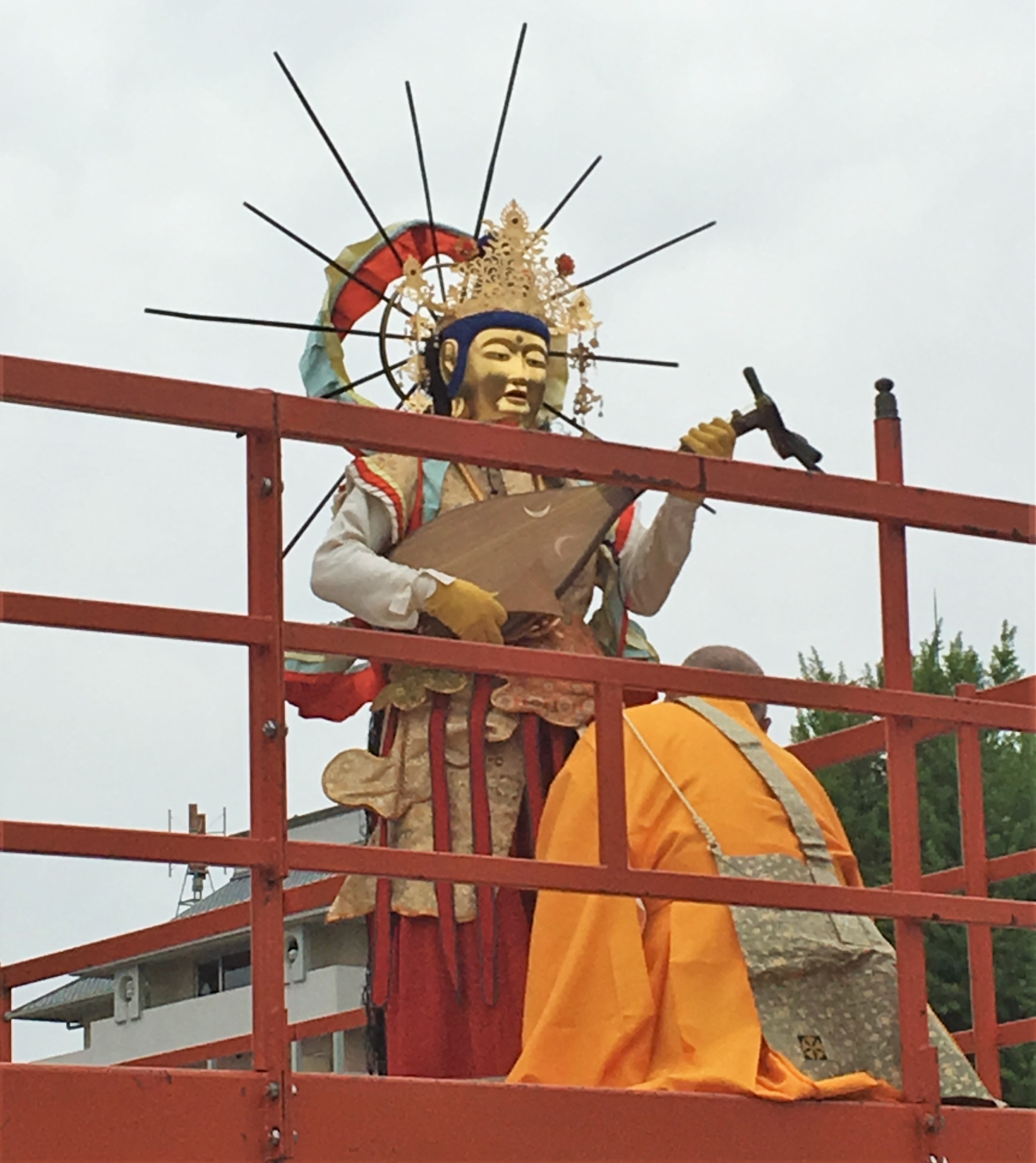Dainenbutsuji Temple, A Parade of Golden Deities
It is common knowledge that most sects of Buddhism sects in Japan, many of them were brought from China. From when Prince Shotoku began spreading Buddhism, to Kukai, who introduced the Shingon or Mikkyo sect to Japan– practicing Buddhism meant Chinese Buddhism. It wasn’t until the late Heian and early Kamakura Period that Japan started to invent its denominations, such as Jyodo-shin or Nichiren. Among those sects created in Japan, the first one was the Yuzu Nenbutsu sect. Surprisingly, the main temple of this sect, Dainenbutsuji temple, is in Osaka City’s Hirano ward.
The History of Dainebutsuji Temple
In the late Heian period, a monk called Ryorin [良忍], practiced in Mt. Hiei-zan in Kyoto, but due to political tension, he left Hiei-zan and moved to Ohara in Kyoto. One day,while he deep in meditation, *Amidanyorai appeared to him in a vision. Amidanyorai taught Ryorin special chants that he said would help bring people to enlightenment. This vision lead Ryorin to create the Yuzu Nenbutsu school of Buddhism. After gaining support from Emperor Toba, Ryonin built the main temple of Yuzu Nenbutsu, Dainenbutsuji Temple [大念仏寺], in Hirano, Osaka.

Chanting
Chanting is a principle belief of the Yuzu Nenbutsu sect. Moreover, Yuzu Nenbutsu was one of the first sects of Buddhism in Japan that introduced vocal chanting as a means for commoners to practice Buddhism. The belief is that your chant combines with other people’s chants. This gives your chant more power and helps lead people to heaven, i.e. Gokuraku Jodo.
The Expansion of Yuzunenbutsu
Unfortunately, Yuzu Nenbutsu had a hard time finding powerful leader after Ryorin, so their popularity stayed relatively small. Then in 1700 a terrible fire burnt down Dainenbutsuji Temple. With their main temple in ruin the Yuzu Nenbutsu sect nearly evaporated. It was only after the Edo period that a monk named Daitsu revived the Yuzu Nenbutsu sect. Since then, the Yuzu Nenbutsu sect has grown tremendously, and is one of the main 13 sects of Buddhism in Japan, with most of its followers living in the Kansai region.
Temple Grounds
The temple grounds are so expansive that we were surprised that such a large temple exists so close to many of Osaka large sky rises.

Once you enter the temple ground, you will see the hondo, which was built in 1938. The hondo is huge! At 50m wide and 40m long Dainenbutsuji’s hondo is the biggest wooden structure in Osaka prefecture. Feel free to enter the hondo and walk around! If you are lucky, you might even be able to hear them chanting.

The hondo enshrines a painting of Jyuichisontentokunyorai [十一尊天得如来]. During the end of the year (September- December) the monks perform a Okaizai [御回在] where the bring the painting out of the hondo and into the homes of their followers. There, they chant with the family and perform a special service. Only the Yuzu Nenbutsu sect performs okaizai!
The Reimeiden enshrines Tokugawa Ieyasu and Emperor Toba. Near the end of the Seige of Osaka, Tokugawa stopped by Dainenbutsuji to pray for victory. Once Hideyoshi was defeated, Tokugawa returned to the temple to thank them for his victory. As thanks, the head priest asked Tokugawa for a license so they could spread the teaching of the Yuzu Nenbutsu sect.

Ghoulish Scrolls
This treasure storage house is famous because it contains some spooky scrolls! Somehow, during the Edo Period, Dainenbutsuji came into possession of 12 scrolls, each with a painting of different kind of Japanese ghost. No one knows how or why the scrolls are there, but many of the ghosts are common in kabuki and bunraku plays.

The storage unit also contains a piece of cloth believed to once belong to an actual ghost.
The story goes that one night, a man traveling to Hakone came across a woman on the road. The woman said that in life, she was the wife of a Sumiyoshi Taisha’s priest, but now she was trapped in hell! She was searching for Dainenbutsuji in the hopes of finding her way to heaven. She then tore off a piece of her sleeve and gave it to the man, asking him to take it Dainenbutsuji to pray on her behalf. The man did as she asked, and thankfully, the woman’s soul at last entered heaven.

The scrolls and the ghosts sleeve can be seen once a year, on the fourth Sunday of August
Manbu Oneri Ritual
One the most famous festival held at this temple is the Manbu Oneri Ritual. The ritual takes place on May 1st– 5th every year. Monk Homei started the festival in 1349, taking inspiration from Taima-ji Temple’s Manbu Oneri in Nara.
During the ritual, monks dress up as the 25 bosatsu that appear when someone dies, and walk on a tall bridge around the hondo.

If you don’t know what a bosatsu is, check out our Basic Guide to Japanese Temples, to learn about bosatsu and other temple deities.


If this ritual is really fascinating to you, check out Taima-dera! Taima-dera in Nara is the first temple to ever hold and Manbu Oneri ritual and they still do this day! Read more about the temple in our blog post Taima-dera and Princess Chujo’s Mandala.
Dainenbutsuji Temple
| Address | 1-7-26 Hirano Uemachi, Hirano Ward, Osaka City, Osaka Prefecture |
| Website | http://www.dainenbutsuji.com/ |
| Hours of Operation | Mon-Sun 9:30-17:00 |
| Admission Fee | Free |


Leave a Reply